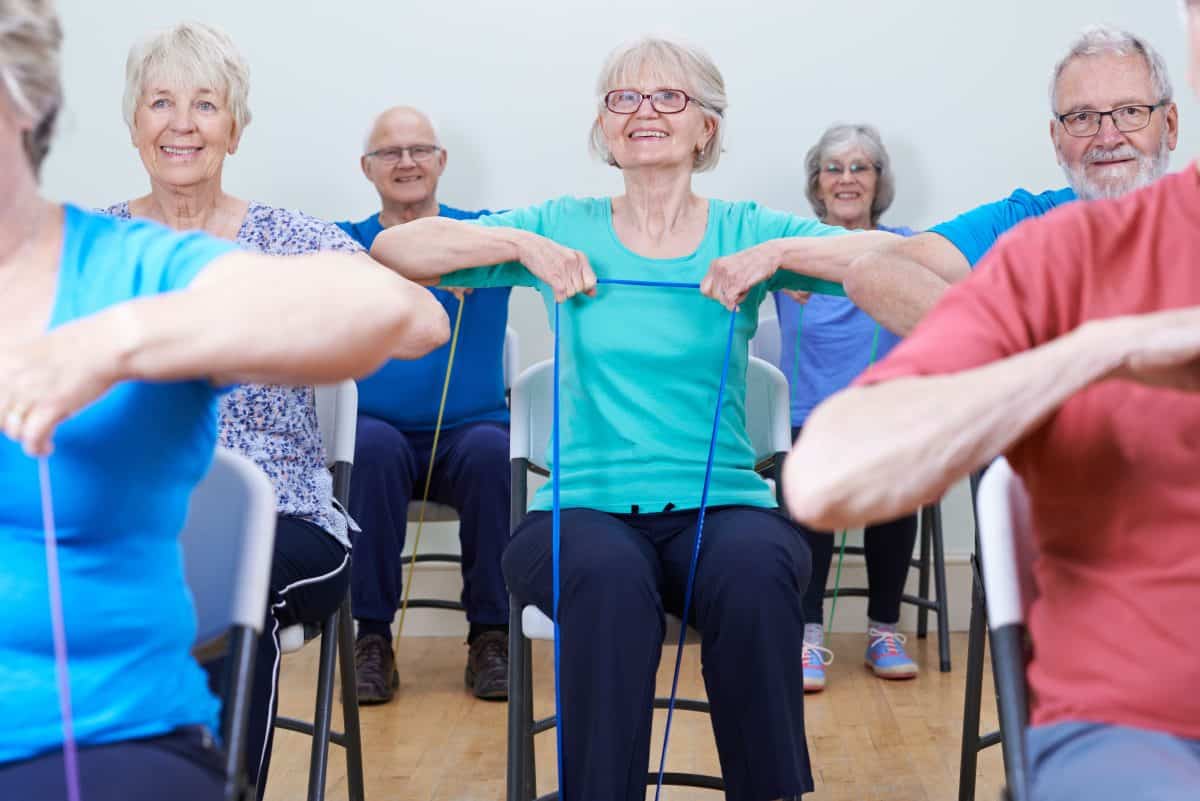
Strengthening for Seniors: Seated Exercises Can Give You a Serious Workout!
You’ve probably heard of chair exercises, but maybe you haven’t given them a second thought. Some people think that seated exercises are for those who can’t do “regular” exercises, for whatever reason.
It’s true that chair exercises are excellent for people with limited mobility, as well as those who have issues with balance or strength and those who are recovering from an illness, injury or surgery. However, they’re effective for nearly anyone who’s looking for a well-rounded exercise routine. With a stable chair and the right attitude, your seated exercise regimen can give you the same kind of results you’d get from a more traditional type of workout!
Social Activity or Class of One — It’s All Good!
Most senior living communities offer seated exercise classes, such as chair aerobics (or chairobics), chair yoga and maybe even chair tai chi, as a regular component of their scheduled activities for seniors. Many fitness facilities and community senior centers also offer these types of classes.
It’s helpful, at least in the beginning, to have an instructor show you how to do the exercises correctly. If you’re doing your chair exercises at home, you can do an online search for videos that will guide you through them. YouTube is a very good source — just search for “chair exercises for seniors” and you’ll see what we mean.
There are also plenty of other websites that describe detailed steps for performing seated exercises and provide illustrations to help you make sure you’re doing all the right moves.
An added benefit you’ll derive from taking a class with others is the fun you’ll have being a part of the group experience. You’ll probably even share a laugh or two. Seeing others doing the movements can also be a source of motivation!
What Makes Chair Aerobics Great for Seniors
As noted earlier, seated exercises are great for people of all ages. They can be especially good for older adults, though, for many reasons:
- Reduces the risk of falling. With age, balance can become more of an issue. Whether you use the chair to sit in or to hold on to while doing standing exercises, you’re far less likely to fall and injure yourself. Plus, as you get stronger, you’ll likely find your balance improving.
- Gentler on the joints. Traditional standing exercises can be difficult for people who have stiffness and joint pain from arthritis or the wear and tear that comes with age. Chair aerobics and other seated exercises ease the burden on your joints and can often help alleviate joint pain.
- Increases flexibility and range of motion. Age can often lead to a loss of flexibility and range of motion. That, in turn, can make exercise of any kind challenging. Chair exercises can gradually, and safely, increase both flexibility and range of motion so they’re closer to what they once were — and help prevent further decline as the years go by.
- Easy way to start exercising. It doesn’t take long for a sedentary lifestyle to have adverse effects. If it’s been a while since you’ve been physically active, then starting with some simple chair exercises is a great way to ease back into being more active. You may eventually decide to move on to other forms of exercise, or you might like chair aerobics so much that you want to stick with it!
- Improves muscle strength and heart health. Seated exercises aren’t just good for improving balance and range of motion. Just as you’d expect from a traditional strength-training or cardiovascular workout, chair aerobics and other chair exercises can help make you stronger (including your legs) and keep your heart healthy.
- Increases blood circulation. Who knew that sitting in a chair could help lower your risk of stroke, heart attack and high blood pressure? The key, of course, is to move while you’re seated, and that’s just what you’ll do with chair aerobics!
- Lowers stress. Whether you’re taking a class or doing your chair exercises at home, you’re virtually guaranteed to feel less stressed by the time you’re done. Exercise alters the level of certain chemicals in your brain, which can reduce your stress level, improve your mood and even help you sleep better. You might notice that your concentration is better, too.
- Helps prevent chronic disease. Exercise can make a big difference when it comes to reducing the risk of diabetes and other chronic illnesses. For some people, the combination of exercise and changes in diet can even lead to less (or no) need for medication to control diabetes, high blood pressure and other chronic illnesses.
- Adds variety. One reason people stop exercising is because it gets to be monotonous. After all, we often refer to exercise as our workout “routine.” Chairobics can be a welcome addition to other forms of exercise, such as stretch classes and water aerobics.
- Reduces the risk of dementia. Being physically active makes it less likely that you’ll experience a decline in mental function. Your risk of developing dementia, including Alzheimer’s disease, is also lower than if you were sedentary. So have a seat and get moving!
Getting Started
By now you may be feeling enthused and ready to give chair aerobics a try. If so, that’s great! Before you do, though, there are a few safety considerations to take into account.
Check With Your Doctor
As with any new physical activity, it’s a good idea to check with your doctor before starting a seated exercise program — particularly if you’ve recently had surgery or you’re recovering from an illness or injury. Also, if you discover that you’re unable to do any of the movements as they should be done, it’s worth bringing it up to your doctor.
Use the Right ‘Equipment’
While you might eventually want to add wrist weights, dumbbells, a medicine ball or an exercise band, all you really need to begin with is a stable chair. The best choice is one with a straight back, no arms and a comfortable, cushioned seat. You don’t want to use a chair with rollers that could send you scooting across the floor.
Be Sure to Warm Up
Just as you should do certain stretches and movements before working out on fitness machines, it’s best to do some basic stretches before delving into your chair exercises.
Start by loosening up your neck and shoulders, and then continue with your arms, hands, fingers, wrists, elbows, hips, knees and ankles. Along the way, add some twists and forward folds to wake up your core. Finish by marching in your chair to get your heart, lungs and circulatory system ready for what’s ahead.
Begin Gradually
The last thing you want to do is wind up with an injury. That’s why it’s important to start slowly and add to your chair routine as you’re ready. Don’t overexert yourself. Your body will tell you when it’s had enough.
For most seniors, the target is to do 30 minutes of seated exercises two to four times a week. If that sounds intimidating, start with a few minutes here and there and slowly increase the amount of time.
Remember, any amount of exercise is better than none at all. The point is to move. Physical activity at any level can help you reduce your risk of disease, including arthritis and general physical decline.
Chair Exercises for Your Whole Body
You may be pleasantly surprised to learn that nearly any exercise you can do while standing can be modified and done in or with a chair. Chair aerobics for seniors can even include running and jumping jacks!
When you’re ready, add an exercise band and a medicine ball, and you’ll have everything you need to get a highly effective full-body workout.
Examples of chair exercises for your arms and upper body:
- Bicep curls
- Isolated tricep extensions
- Shoulder rolls and front shoulder raises
- Shoulder press
Examples of chair exercises for your legs:
- Sit-to-stands
- Modified squats
- Knee extensions
- Heel slides
Examples of chair exercises for your core:
- Knee-to-chest
- Leg kicks
- Tummy twists
- Extended leg raises
Wellness at Asbury Village
If you’re exploring retirement communities in Illinois, you’ll find that just about all of them offer fitness classes among their activities for seniors. Most, including Asbury Village, offer classes with chair exercises.
As a Life Plan Community, we take a holistic approach to wellness. Physical activity and exercise are one of eight components we focus on to help residents in our community be their healthiest.
We invite you to find out more about how our comprehensive perspective on well-being can add to your good health and happiness. If it inspires you, we hope you’ll contact us to set up a time to come visit. We’d love to show you around our community!
